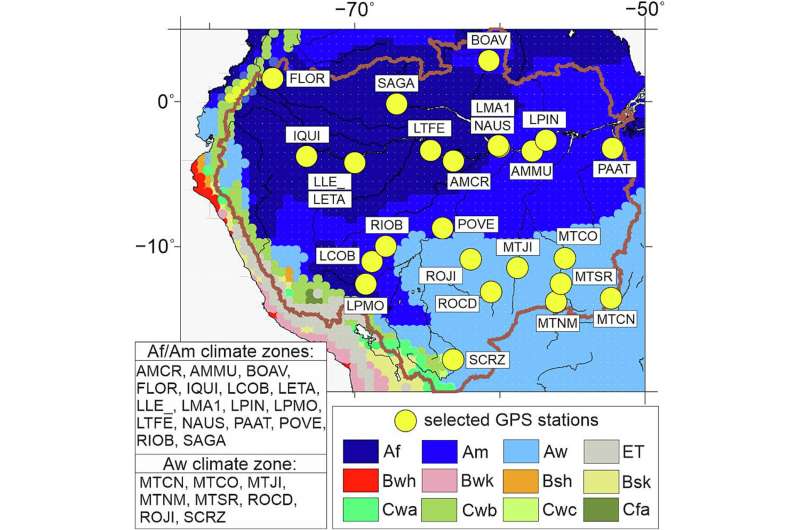Integrating satellite systems provides drought detection from space

Location of 25 GPS stations used in this analysis. These stations have recently been found reliable for studying temporal changes in the terrestrial hydrosphere (Klos et al., 2023) (yellow dots). The background colors show the climate indicated by the Köppen-Geiger classification for the Amazon region, where several classifications are shown: tropical (A), arid (B), temperate (C) and polar (E) of the major climate groups. For details on climate conditions, see Kottek et al. (2006). (For an explanation of the color references in this story, the reader is directed to the web version of this article.) Credit: Remote Sensing of Environment (2024). DOI: 10.1016/j.rse.2024.114464
Observing places like the Amazon region from space has improved the ability of satellites to better detect signs of drought, according to a new study.
Led by the Polish Military University of Technology and Griffith University, researchers combined two advanced satellite systems to improve drought monitoring. The study “A new Multivariate Drought Severity Index to identify short-term hydrological indicators: a case study of the Amazon River” was published in Remote Sensing of Environment.
Advanced satellite-based techniques, such as the Global Positioning System (GPS) and the Gravity Recovery and Climate Experiment (GRACE), have been invaluable in tracking changes in freshwater worldwide, including freshwater. underground. However, Dr. Christopher Ndehedehe, co-author and ARC DECRA Fellow at Griffith’s Australian Rivers Institute said these methods have limitations.
“GRACE provides reliable data at large and regional scales but struggles at local scales, while GPS data can be affected by technical and environmental factors including, elevation instability, land expansion on temperature, errors caused by ocean currents, and measuring real changes in the hydrosphere can sometimes be difficult, among several other issues, “said Dr. Take care of me.
“Both methods also face difficulties in capturing temporary extreme hydrological events such as sudden droughts and may underestimate or overestimate the occurrence and severity of such events.”
To overcome this challenge, the research team developed a new method by combining GPS power with GRACE-based vertical displacement data to effectively monitor drought. This new method was tested in the Amazon region and California’s Central Valley where water changes were strong and could provide important information for water management.
“By combining GPS and GRACE data, the new drought indicator improves our ability to accurately track short-term drought events, providing timely and actionable information for decision makers,” said Dr. Take care of me.
“Adaptation plans to reduce the effects of climate change must include the intelligent management of water resources and the development of appropriate indicators and metrics to assess the effects of drought on freshwater.”
Although each method (GPS and GRACE) individually showed good spatial and temporal agreement with traditional drought indices (eg standardized precipitation index), some extreme events were wrong.
To overcome this, the team developed a multivariate drought severity index (Multivariate Drought Severity Index) by combining GPS and GRACE datasets, using advanced statistical methods known as Frank copulas, combining data from in two types of satellites.
This allowed researchers to detect previously unknown drought events and their effects on freshwater systems.
According to Dr. Artur Lenczuk, Assistant Professor and lead author from the Polish Military University of Technology, “Drought is complex, and its consequences can be very destructive, especially in regions with different climates. .is important for water resources management.
“The multivariate drought indicator has shown strong temporal correlation with drought indicators based on in-situ river discharge data and satellite-based agricultural indices such as the Enhanced Vegetation Index, confirming its accuracy and provide a complete picture of drought conditions.
This new approach provided a comprehensive overview of drought conditions, supporting better resource management and representing an important advance in the drought reassessment process, with wide-ranging implications for global water management strategies. .
As climate change has intensified, regions around the world have faced more frequent and severe droughts, with significant impacts on ecosystems, communities and water resources. Monitoring these changes in climate and water storage was essential for informed water management.
Additional information:
Artur Lenczuk et al, A new Multivariate Drought Severity Index to identify short-term hydrological indicators: a case study of the Amazon River, Remote Sensing of Environment (2024). DOI: 10.1016/j.rse.2024.114464
Provided by Griffith University
Excerpt: Combining satellite methods to provide drought detection from space (2024, October 21) retrieved on October 21, 2024 from https://phys.org/news/2024-10-combining-satellite-methods -drought-space.html
This document is subject to copyright. Except for any legitimate activity for the purpose of private study or research, no part may be reproduced without written permission. Content is provided for informational purposes only.
#Integrating #satellite #systems #drought #detection #space
